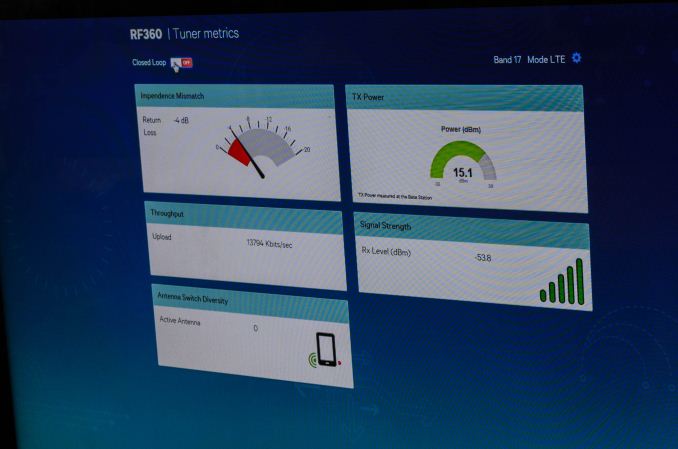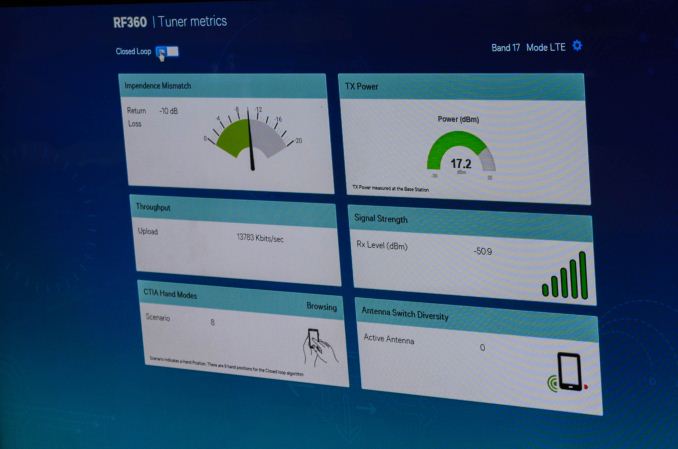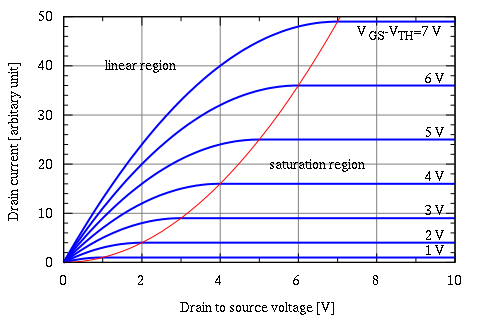Understanding Qualcomm's Snapdragon 810: Performance Preview
by Joshua Ho & Andrei Frumusanu on February 12, 2015 9:00 AM EST- Posted in
- SoCs
- Qualcomm
- Mobile
- Gobi
- Snapdragon 810
QFE2550 Antenna Tuner
One of the first areas to explore would be the RF front end, and before we jump into deep discussions we’ll tackle some of the simpler sections first. The QFE25xx antenna tuner is similar to the envelope tracker in the sense that it’s normally not part of the RF front end. I never actually mentioned an envelope tracker or antenna tuner at any step in the introduction. This is because these parts are not part of the basic superheterodyne radio system. However, like envelope tracking, the need for more battery life, faster data, and superior reception has driven the development of new technologies.
To understand how this antenna tuner works, we must introduce the concept of impedance matching and impedance. Impedance seems difficult at first, but is really just a form of resistance in an AC circuit for the purposes of understanding this article. The three components in a circuit that affect impedance are resistors, capacitors, and inductors. Impedance matching is exactly what it sounds like, which is equalizing the impedance at a junction. In transferring energy from an antenna to the RF front end, we must match the impedance between the antenna and front end. This is because if the impedances are mismatched, signal reflects back to the source. In other words, on the receiving side reception becomes weaker if impedance is mismatched, and on the transmission side energy is wasted. One can liken this to a glossy display, as while the vast majority of the light goes through the glass cover, some light is reflected back.
Of course, in the factory the RF system is carefully tuned to ensure that impedance mismatch is as low as possible. However, the real world makes for a difficult situation. The iPhone 4’s death grip behavior is a classic example of how real-world use can disrupt this impedance matching. By bridging two gaps in the metal ring of the iPhone 4, the antenna was detuned and its impedance was altered. As a result, signal became noticeably worse. Combined with the compressed signal representation, this made it possible for a “decent signal” to be completely lost by touching the right place on the phone.
This is where the QFE2550 antenna tuner and similar systems come in. By acting as a voltage-controlled variable capacitor, the baseband can be loaded with information that allows it to predict how much mismatch correction is needed for each detected scenario, which is accomplished with various sensors that can include capacitive touch sensors. Each situation is compensated for by using pre-loaded corrections that are loaded when a given scenario is detected based on frequency change or body loading scenarios. As a result, the efficiency of the antenna is restored as seen in the photo above, although the presence of body loading will inevitably reduce peak power and sensitivity. Such a system can be combined with more information, such as capacitive touch sensors or reflected power measurements to ensure maximum responsiveness and performance. This has the greatest benefit in enabling phones with all-metal unibodies, although other tools such as antenna switched diversity and MIMO can be used to ensure peak reception.
QFE33xx CMOS PA/Switch
Normally, power amplifiers are not worth talking about. However, with the introduction of RF360 Qualcomm has bandied about the concept of a CMOS PA to cover a wide swath of bands rather than just a few. While this sounds interesting, there’s a great deal more nuance to this issue than simply band coverage. First, semiconductor/solid state physics is required to really understand where the debate lies. Of course, there’s really no time to go over this in major depth, but there are a few basics. The transistor is a switch that controls the flow of current. However, there is a limit to how much current can be carried, and there are a few regions in which the relationship between voltage and current differ. The two that we’ll talk about are the linear region and saturation region. The linear region is exactly what it sounds like. Voltage and current are linearly related, following Ohm’s law. The saturation region is where this falls apart, and more voltage is needed to increase current by the same amount, and we see diminishing returns until maximum current is reached.
"IvsV mosfet" by User:CyrilB. Licensed under CC BY-SA 3.0 via Wikimedia Commons
So this is where we see a fundamental difference in the implementation of a CMOS PA and GaAs PA. Gallium arsenide has higher electron mobility, even in saturation mode. This makes it easier for GaAs circuits to switch at incredibly high frequencies such as 60 GHz for WiGig/802.11ad. In addition, unlike silicon-based transistors, gallium arsenide transistors are generally heat-insensitive, and pure GaAs has high resistance and dielectric constant, which means that it serves as an excellent substrate for various components for the same reasons that silicon-on-insulator (SOI) is a good substrate for CMOS logic. In addition, GaAs-based transistors are highly linear in behavior when compared to CMOS technologies, so a GaAs PA can operate much closer to maximum current without clipping the signal.
However, GaAs is not perfect. For one, CMOS logic is impossible to implement using current technologies. This is because unlike current CMOS technology where there are NMOS and PMOS transistors, GaAs-based transistors do not have a p-channel equivalent. As a result, the controls available over a GaAs PA are significantly cruder than what is possible with a CMOS PA. GaAs PAs are also noticeably less efficient at low power levels, also known as the backoff condition. Therefore, CMOS PAs tend to be more power efficient at lower power states as they can have multiple “maximum power states” to scale the PA as needed. In practice, Qualcomm claims that we’re still looking at around a 5-10% efficiency delta at max power when compared to GaAs PAs, which means that CMOS PAs are close to GaAs PAs in efficiency.
Despite the differences in efficiency, a CMOS PA is still a valid option in smartphones due to the fact that a single PA can cover far more bands than an equivalent GaAs PA, as the PAE curve across a spread of frequencies is relatively flat compared to a GaAs PA which is effectively a single peak. In addition, the fact that the PA is built on CMOS means that there is additional integration capability. In its current incarnation, the QFE33xx already has an integrated antenna switch, and there is potential for greater integration with parts that share a similar process node.
This concludes RF360, which gives a broad survey of what’s on the market today. Combined with our previous piece on MDM9x25, it’s possible to get a good idea of the current state of the market. However, the latest and greatest modems and transceivers mean that it’s time to talk about UE category 6, 9, and 10 LTE and the various challenges that come with new capabilities.














119 Comments
View All Comments
TerdFerguson - Thursday, February 12, 2015 - link
I'm inclined to agree with you, especially after seeing the dual-channel 32-bit bus being described as having a total of 64 bits. Wow, that's as bad as marketing for 1990s consoles.extide - Thursday, February 12, 2015 - link
How is that bad marketing? A dual channel 32-bit bus IS effectively 64-bits wide ...dawheat - Thursday, February 12, 2015 - link
The reference platform has a 6.2” display - making it quite the gigantic phone. I'm guessing it avoids thermal issues which may impact other, more normal size phones.Andrei Frumusanu - Thursday, February 12, 2015 - link
The preview tests were actually done on the MDP tablet, not the MDP phone.dawheat - Thursday, February 12, 2015 - link
Ouch - then this is really best-case performance of the S810 as I'd imagine the tablet MDP has way higher thermal headroom than the phones it's being compared to.lopri - Thursday, February 12, 2015 - link
I am usually very harsh on reviewers, but I do not think your argument holds up. Exynos 5433 is a vanity product. While technically interesting, it is used for one product (afaik) and even that product is not widely available. I would definitely prefer to learn the improvement of the S810 over S800/S805, being Qualcomm's generational product.And it is not like the review tried to hide the Exynos 5433 or anything. The numbers are right there for you to see. Furthermore, AT covered the Exynos 5433 very extensively only a few days ago.
Likewise, throttling or power is meaningless at this stage without knowing what the shipping product is going to be like. And I expect to see those information in due time. Unless you can point to false benchmark data, I do not see the merit in picking on every single aspect of an SOC that was not covered (yet).
Not everyone wants to read corporate conspiracy theories on a tech article, either. I, for one, do not like to read unverified rumors in a technical article.
Only thing that I agree with you about is the missing clock frequency information on the charts. But again, the focus is rightfully on S805 v. S810. I will give the authors a benefit of doubt.
Only thing that I do not like about the article is its timing. I mean, I haven't even finished the Exynos 5433 article yet and there are already 2 laptop articles and now an introduction to the S810.. It's too much information for me to digest. Obviously this is a subject point, and I do not expect everyone to agree with me.
warreo - Thursday, February 12, 2015 - link
Exynos 5433 is indeed a vanity product, nobody is arguing otherwise. You are missing the point that I made earlier. Exynos 5433 is the immediate predecessor to the 7420. Hence, comparing the S810 to the 5433 is a good starting point for how the S810 will compare to the 7420, and it would be one completely based on real, hard data, not just speculation. Are you honestly saying that you would not be interested in a better preview of how the S810 vs. Exynos 7420 will shake out?lopri - Thursday, February 12, 2015 - link
I mean, if AT really wanted to boost S810's image the authors could have omitted the number from 5433 in Geekbench sub-score comparison. The rest of the charts also look free of manipulation, so I do not see how you get the impression.As you can see from this very comment section, not everyone is impressed by the S810. Apparently the authors did not do a good enough job - you know, the job you are insinuating here.
warreo - Thursday, February 12, 2015 - link
True enough, but the fact that AT provides the 5433 data makes it more mystifying why they almost completely gloss over it in the text (not to mention not provide the % differences in the tables). Josh and Andrei have already stated they intentionally kept the focus on S805 vs. S810, but my point is this would be a much stronger article if there was more depth given to the Exynos 5433 comparison. Clearly, I'm not the only one who thinks so.Tchamber - Friday, February 13, 2015 - link
@warreoGet over yourself. So far the 5433 has made it into one product. We all know that it's a good performer, but the Snapdragon line makes it into many more devices...always has. What your asking would be like me writing to Car and Driver and saying "hey, you are guys are doing your comparisons wrong. I want you test your Corvettes, Camarros, and GT500s against a Lamborghini Aventador." Well, they have all the test results from the Lamobo...but that's just not what the others were made to compete with, so it would be meaningless to run them against each other at the road course. Do your own math if you don't like not seeing a percent sign with easy to digest material. All the time you've been talking down to AT you could have posted your own conclusions and helped out all those people who agree with you.